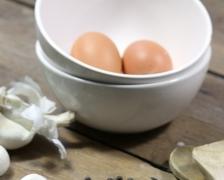[dropcap style=”font-size:100px; color:#992211;”]P[/dropcap]erhaps in homage to the unexpected blue stuff that has been sighted in northern hemisphere skies of late, Trebuchet invites you to partake in an activity that signals the onset of summer.
Mayonnaise. The making thereof. An act which, due to the feeble nature of our central heating systems and the parsimonious nature of those who guide the tiller of the thermostat, can rarely be achieved when there is an ‘r’ in the month.
A shame, because the joy of home-made mayonnaise is not simply in the final product. Nowhere is the alchemy of the saucier more simple or more satisfying. Hollandaise comes close, although not without a great deal of undue stress (applying both acid and heat to eggyolks whilst expecting a glossy, silken end product stretches the laws of physics in ways which are, frankly, provocative).
Anyway, you can get a half-decent carton of Hollandaise from a supermarket – the same cannot be said of mayonnaise.
The reason being raw eggs, and mass- production’s appalling track record with the same. You, however, are not a factory, and unless you suffer from particularly litigious house-guests, are unlikely to be reduced to bankrupt penury by a disgruntled chancer with a dickie tummy who’s seen a less capricious route to unearned lucre than the Euromillions draw.
So onwards, to the savoury custard of kings. Or generals at least. The sauce’s origins are muddied somewhat. Most enduring is that the name is a corruption of ‘Mahon’ – the Menorcan capital – brought to France by a victorious General du Plessis. That interpretation puts it bang at the start of the Seven Year War, in 1756. Which, given that formidable matriarchs guard generations-old versions of the similar salsa aioli to their black-starched bosoms the length of the Costa Brava, smacks a little of French culinary chauvinism.
Nevertheless, it is the French who are most associated with the confection, and perhaps they should be granted that small consolation, now that The Simpsons has forever established ‘cheese-eating surrender monkeys’ as the go-to national description. A cultural claim on mayonnaise is paltry recompense.
So why wait until summer to make your own version of a sauce that, once made from scratch, will ruin forever your enjoyment of the almost-unrelated commercial product? The answer is all in the ambient temperature. Eggs, oil, mixing bowl, even the whisk must be warm for the desired end result. Neither does there seem to be a way to cheat. Take a warm day, a very fresh free-range egg, and get cracking (pun intended).
Ingredients:
One free-range egg yolk.
250 ml sunflower oil
Salt, pepper, mustard, lemon juice to taste.
Method:
OK, there’s already a controversy in the ingredients. The oil, the oil, the oil. Yes, the original recipe certainly calls for olive oil. Green and spicy, first pressing, foot-squished by dusky maidens and untouched by human hand. And for some reason, far more likely to curdle the eggs. It also imparts a very strong taste of olive to the sauce, which is fine if you want it, but a bit imposing if not. For a more versatile mayonnaise, stick to humble sunflower.
Other than that, it’s a case of cossetting. No sudden movements, no nasty surprises. Which is why, after you’ve split your eggyolk from its surrounding albumen, you should bathe it gently in a (round-bottomed) bowl of warm water. They’re sensitive.
Once you’re happy that the yolk is warmed through, pour off the water and break the yolk with a balloon whisk. Briskly stir (not whisk) the yolk in a single direction, and gently drizzle the oil on top as you stir. With luck, the mixture will thicken and lighten in colour. Keep adding the oil until it has all emulsified into a glorious, custard-hued stiff sauce. And that’s it.
Culinary doyenne of the ’60s Elizabeth David claims that you can keep adding the oil far beyond this point. She’s likely right, although it does lead to a pallid mayonnaise. Salt should be added at this final point, as can a touch of lemon juice, (walnut vinegar is also good). Further flavourings such as garlic, chopped chili, mustard or ginger can also be added. You can add them at the start, but it makes curdling more likely.
As to curdling. It does happen from time to time, and it’s a bummer. If you are unlucky and your mixture ends up looking like sloppy scrambled eggs, you can start again with washed, warmed implements. If your second attempt emulsifies well, the curdled mix can be gradually added to the successful mix, thus meaning that it will take more oil and give you double the volume when you’ve finished.
If your second mix doesn’t work out, abandon the effort, reintroduce the eggwhites, and have scrambled egg instead.
Image by freedigitalphotos.net/Simon Howden
Sean Keenan used to write. Now he edits, and gets very annoyed about the word ‘ethereal’. Likely to bite anyone using the form ‘I’m loving….’. Don’t start him on the misuse of three-dot ellipses.
Divides his time between mid-Spain and South-West France, like one of those bucktoothed, fur-clad minor-aristocracy ogresses you see in Hello magazine, only without the naff chandeliers.
Twitter: @seaninspain




















